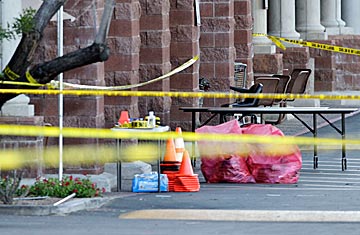
The entrance of a Safeway supermarket where U.S. Rep. Gabrielle Giffords, and others were shot.
There was no premonition of trouble. For Congresswoman Gabrielle Giffords and her staff, Saturday morning at the Safeway at Tucson's La Toscana mall was a routine preparation for one of her regular town hall meetings, "Congress on Your Corner."
The events were popular and always well-attended. By the 10 a.m. start time, about 25 constituents had arrived to wait in line for to speak to the Congresswoman. As usual at these events, she planned to give each constituent three to four minutes of individual attention, explains long-time intern Alex Villec, 19. The one-on-one chats were decidedly apolitical, he explains, and rarely drew the kind of partisan heat that Giffords had grown accustomed to in other settings — particularly the heated debates and confrontations over Obamacare and immigration. "This was as non-partisan as it gets," Villec says. "She wasn't there to champion a piece of legislation or to argue a point. She was just there to meet one-on-one with constituents who had personal issues to talk about."
Villec, 19, a sophomore Georgetown University economics and government major, had worked for Giffords for a while. He had walked door-to-door with Giffords during her 2008 re-election campaign and interned for her both in Washington and in Tucson during time off from school. On Saturday, as Giffords began talking to the first folks in line in front of Safeway, Villec stood at a table about 10 to 15 feet in front of supermarket's sliding front doors.
A couple minutes after 10, Villec says he was approached by a clean-shaven young man in a dark skullcap or beanie pulled so tight over his head he might have been bald for all the hair Villec could see. He wore a baggy dark coat, and blue jeans and asking the intern if he could speak to the congresswoman. In hindsight, Villec calls the conversation "chilling" because the man was fidgety and had seemed to lose complete interest in what Villec was saying once he was told he had to wait.
"I told him, 'She is meeting with a constituent right now but you are welcome to get in line and wait,'" Villec told TIME, "But he didn't seem interested in what I wanted to say. The eerie thing now is how he dismissed me. As the rest of my words were trailing off, he abruptly turned and left. But it appeared as though he had complied. He went to the back of the line. ... I really thought he was going to wait in line, that is where he was headed, and I kind of lost track of him."
Less than 10 minutes later, the same man walked back up to the table where Villec was fielding questions from late-arriving constituents. But this time he didn't ask any questions. "He didn't acknowledge me at all and walked right past some people who were in front of the table and pushed his way through the little space between the table and a pillar that was to my left. There was maybe a foot gap between the table and the pillar and he just pushed his way through. He was to my left, I wasn't blocking that gap. We hadn't expected to use the table as an obstacle. He just pushed his way through."
Villec did not see the gun. Giffords, he recalls, had just begun talking to the first constituents who had been waiting "when it happened." Out of the corner of his eye, Villec says, "I saw him raise his shooting arm. Then he opened fire."
The ensuing seconds were chaotic and almost impossible to reconstruct from memory. According to other people at the scene, federal district judge John Roll was the firt person shot. But, says Villec, "I couldn't see it with my own eyes. There was just bedlam. Clearly, she was the target, but I am not sure who was shot first." He heard the shots and dove for cover behind a second pillar, one between him and the line of fire. "I took cover behind the pillar as shots were being fired. I saw a man on the ground." Villec now believes the man on the ground was Dorwin Stoddard, 76, who had been trying to protect his wife. "If I am not mistaken, he was one of the constituents who was killed, he had stood in front of his wife."
"I realized I had better get to safety," says Villec. "It was maybe 10 seconds later, and I took off running to a bank about 100 feet away. I sprinted to the bank. I was there in maybe 30 seconds in real time. I think just seconds later, maybe a total of a minute, [then] the first cops got there." Already, says Villec, a sheriff's deputy was running toward the scene. Quickly, he recalls, "police and helicopters and EMS units were arriving everywhere." Twenty people were shot; six people died, including Judge Roll and Villec's mentor in the Giffords' organization, Gabriel Zimmerman. The Congresswoman remains in critical condition after suffering a bullet through her brain.
Why wasn't more security involved, given that Giffords had been threatened before? Villec says security "had come up a lot" during his time working with Giffords. Everyone, he says, was well aware of the vandalism that had taken place at her office just after the healthcare vote last year. The staff was always accustomed to being on alert. But Saturday's event was so non-controversial, he and his co-workers never imagined there would have been any kind of disruption. "I think we have done something like 25 of these before," he explains. "This event was as non-partisan as it gets."
